
People have always wondered
whether or not life exists
elsewhere in our solar system.
Somewhere besides the Earth.
---Percival LowellWe start our tour of the solar system on Earth, the one place we are sure life exists---some of it even seems intelligent. What is so special about the Earth? Just about all scientists think it is the large amounts of liquid water on Earth that aided in the origin of life here. Water plays a vital role in just about all lifeforms on our planet, but it was probably even more important as the host for the first chemical reactions that preceded the first true life. These first chemical reactions, the forerunners to the self-replicating DNA molecules, almost certainly took place in warm pools of water.
The early Earth was an inhospitable place for life: it was nearly airless, it was still hot, and was being bombarded by the refuse leftover from the formation of the solar system. It appears that primitive forms of life existed as far back as 3.5 billion years, about 1 billion years after the Earth's formation. During the first 500 million years or so, the Earth would have been wracked with volcanoes and meteor impacts. Thus, somewhere in the brief interval between 4.0 and 3.5 billion years, the chemistry that was the forerunner of life took place.
The first hints of how this chemistry might have occurred were revealed in a classic experiment by Stanley Miller in the 1950's. Miller took a combination of gases which he believed dominated the early atmosphere of the Earth (hydrogen, methane, ammonia and water vapor), and sent electrical discharges through them to simulate lightning. Within just a few days, a variety of amino acids (the "building blocks of life") were produced in this "primordial soup" experiment. With these building blocks around, it took some other, as yet undetermined, chemistry to form the first self replicating molecule: RNA (go here for a description of this timeline and more on the "RNA world"). Liquid water is almost certainly needed for the start of these processes. It is likely that liquid water is needed for life to arise elsewhere, and thus, our survey for where life might occur in our solar system will be limited by this condition.
What are the physical conditions required for liquid water? Obviously, it must not be so cold that the water is frozen at all times, or so hot, that water never condenses into a liquid (it remains a gas). Thus, for water to be a liquid at the surface of a planet (to first approximation), that planet has to have at temperature above the freezing point of water. The amount of energy emitted per square centimeter by a hot, solid object is given by the equation E=5.67X10-5T4. The total amount of energy radiated by the Sun is simply the area of the Sun (4 pi R2Sun) times this equation: ESun = 7.13x10-4*R2SunT4Sun = 3.8 x 1033ergs/s. The amount of energy flowing through the surface of sphere with the orbital radius of a planet is simply: Ep = ESun(RSun/R2planet). Since this is the energy recieved by a planet, it can converted using the same formula (Eplanet= 5.67x10-5*T4planet) as a temperature: Tplanet = (RSun/Rplanet)1/2TSun. Plugging in the constants, we get Tplanet = 395/R1/2planet, where Rplanet is in Earth-orbit units ("Astronomical Units"). But a planet radiates (and reflects) some of this energy, so the true equation for the temperature of a planet is: Tplanet = 277/R1/2planet K. The temperature units of Kelvin are that where the freezing point of water is 273 K. Thus, the mean temperature of the Earth (if it had no atmosphere) would be four degrees above the freezing point of water! The fact that we have an atmosphere allows us to stay warmer than this. The planet Venus has an orbital radius that is 0.723 times that of Earth, so its mean temperature should be 383 K (230oF). The boiling point of water is 373 K! Mars has an orbital radius of 1.524 times that of Earth, so its mean temperature should be 181 K (-133oF). Since Venus and Mars are the planets that are closest to Earth, it is obvious that even they may not be very good places for hosting life.
But these simple calculations do not tell us what is really happening on these planets. Atmospheric physics is critical for determining what the actual surface temperatures of these planets are. As we have found out, life may exist well below the surface of a planet, deep in the warm rocks. Thus, even the presence of an atmosphere may not be required for life to evolve. So, let's begin our tour, working our way outwards from the Sun.
Mercury is the closest planet to the Sun, and it has no atmosphere. The lack of an atmosphere, and the high tempertures (the Sun-facing side of Mercury has a mean temperature of 700 K!) mean that it is an inhospitable place for life. While the face of Mercury in sunlight is very hot, the other side is very cold, just 100 K, due to the lack of an insulating atmosphere. No life on Mercury!
Venus has nearly same diameter as the Earth: 12,103 km for Venus vs. 12,756 km for the Earth. Venus has a very dense atmosphere, and this atmosphere is mostly carbon dioxide, and there appears to be very little water. The atmosphere is so dense, that at the surface of Venus the pressure is equivalent to that of being at a depth of 1 km in the ocean. This dense atmosphere is responsible for the enormous greenhouse effect on Venus, causing the surface temperature to be 700 K! No life on Venus!
Of all of the planets, Mars has always been the one place in the solar system where we might expect to find life. Mars is much smaller than the Earth, having an equatorial diameter of 6,794 km (about 1/2 that of Earth). It orbits at an average distance of 227,940,000 km (1.52 AU) from the Sun. Mars takes 687 days to orbit the Sun. The length of the Martian "day" is nearly the same as Earth, as Mars rotates once per 24 hours and 37 minutes. Even though it is much smaller than the Earth, because of the latter's oceans, the total land surface area of Mars is just about the same.

Mars has a very tenuous atmosphere, composed mostly of carbon dioxide:
Martian air contains only about 1/1,000 as much water as our air, but even this small amount can condense out, forming clouds that ride high in the atmosphere or swirl around the slopes of towering volcanoes. Local patches of early morning fog can form in valleys. At the Viking Lander 2 site, a thin layer of water frost covered the ground each winter. 2
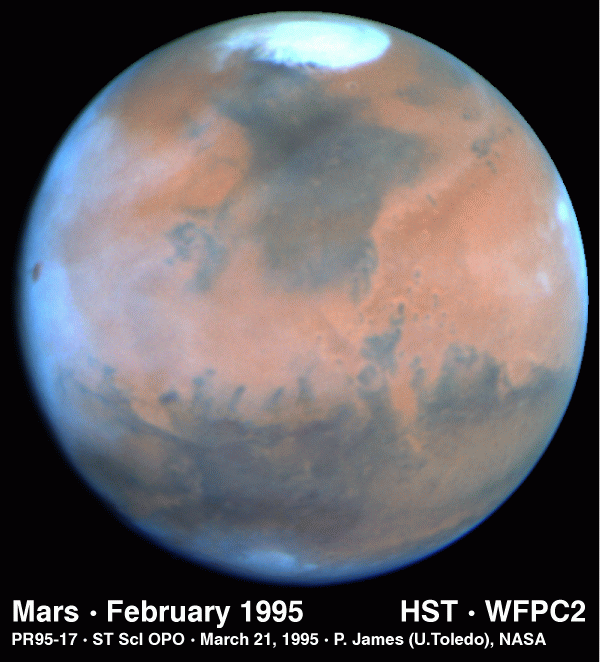

The average recorded temperature on Mars is -55 C (-67o F) with a maximum temperature of 20 C (68o F) and a minimum of -140 C (-220o F).
Barometric pressure varies at each landing site on a semiannual basis. Carbon dioxide, the major constituent of the atmosphere, freezes out to form an immense polar cap, alternately at each pole. The carbon dioxide forms a great cover of snow and then evaporates again with the coming of spring in each hemisphere. When the southern cap was largest, the mean daily pressure observed by Viking Lander 1 was as low as 6.8 millibars; at other times of the year it was as high as 9.0 millibars. The pressures at the Viking Lander 2 site were 7.3 and 10.8 millibars. In comparison, the average pressure of the Earth is 1000 millibars.2
There is certainly water on Mars, some of it locked into the polar caps (though much of what we see in the Martian polar caps is actually frozen carbon dioxide--"dry ice"):
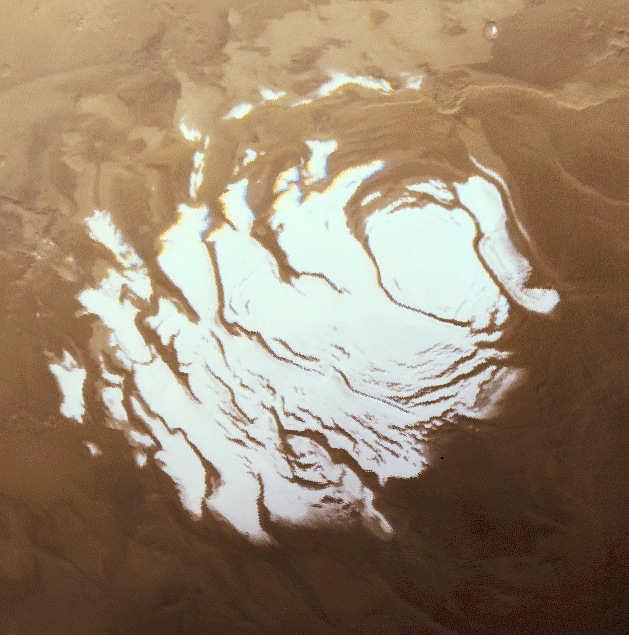
There are a large number of features on Mars which suggest the possibility of flowing water in its past:
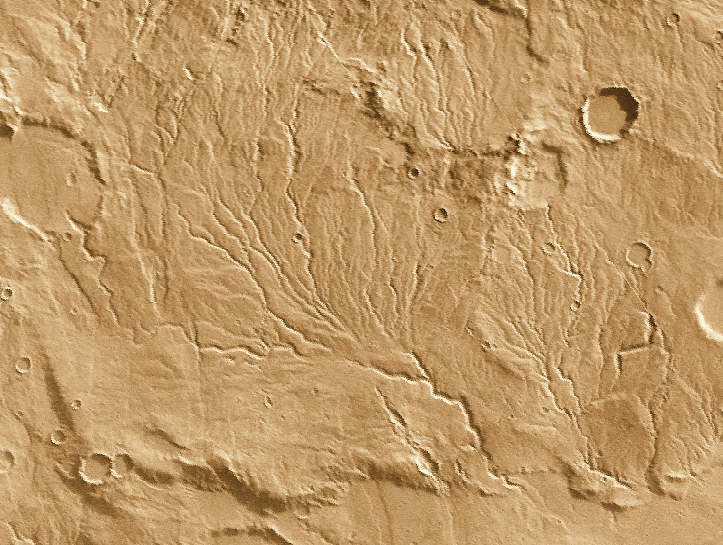
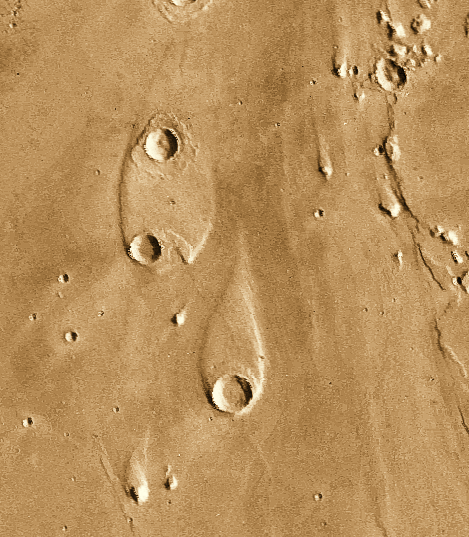
Here is an image of a dust storm rolling across a small region of Mars (just like Las Cruces!):
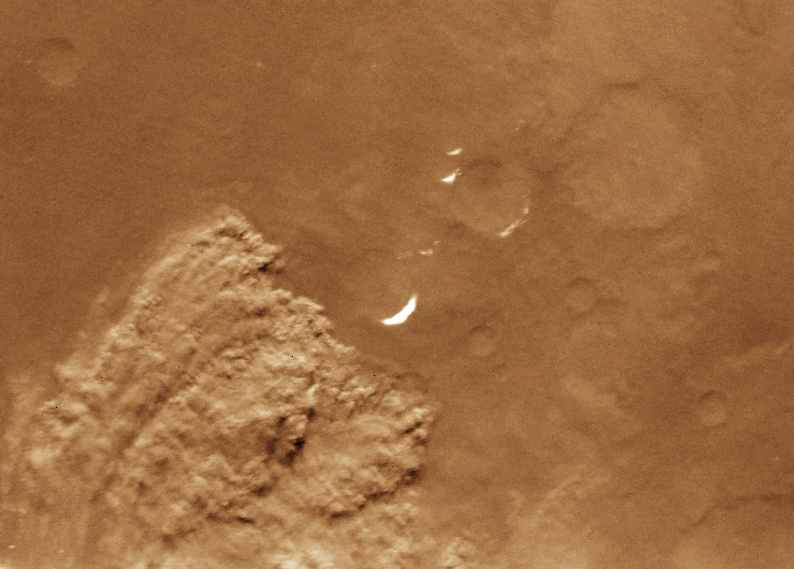
Evidence is growing that just below the Martian surface, there may be considerable amounts of frozen water (go here for a recent press release). This, combined with the abundant evidence for water at earlier times in the history of Mars, suggests that it might have been possible for life to have evolved on Mars. Perhaps, like the extremophiles on Earth, this life now lies buried deep below the surface of Mars where the temperatures are much more hospitable. Many of these ideas are summarized in this document.
Because Mars' atmosphere is so thin, an efficient greenhouse effect does not operate on Mars. There may have been periods in the past when Mars was warmer where much of the carbon dioxide locked into the poles (and elsewhere) was released, making it possible for this to happen. This may happen again in the future, but the exact mechanisms driving these long term climatic cycles have not yet been identified. Many people, however, are now proposing the idea of turning Mars into a warmer, wetter place. This is the concept of "terraforming". Through various means, much of the carbon dioxide locked away in the crust/poles is released, creating a thicker atmosphere with a more efficient greenhouse effect. The planet would thus warm up, and the atmosphere would become even denser. Eventually, it should support liquid water. Here is an interview with someone who wrote their academic thesis on terraforming Mars (showing how seriously some people take this), and here is a down-to-Earth description of the issues.
Jupiter is the fifth planet from the Sun, and is a giant ball of gas. No life can be expected to exist in the cold clouds of Jupiter. The moons of Jupiter, however, are another subject. Jupiter has a large number of known moons (about 58 of them), but most of these are tiny little rocks (< 5 km in radii). There are four major moons of Jupiter: the "Galilean satellites" Io, Europa, Ganymede, and Callisto (shown in order, below).
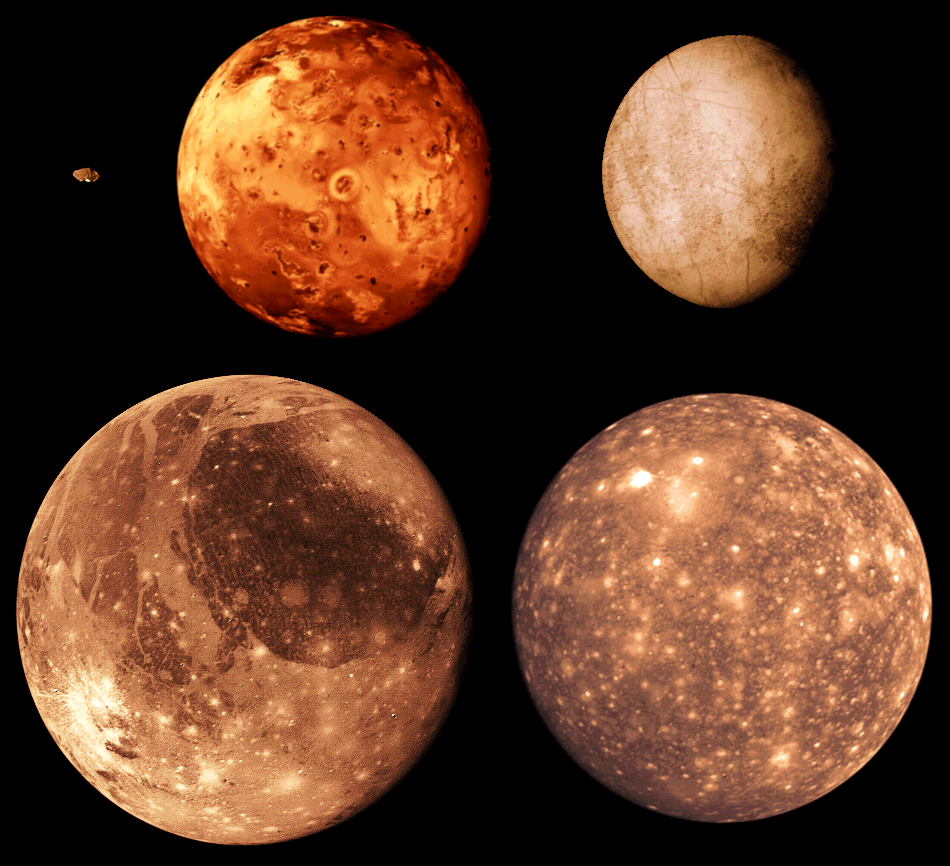
The innermost of these four moons is Io, and its surface is covered with lava flows from the numerous volcanoes on its surface. In fact, Io has the youngest surface in the solar system, being constantly reshaped by volcanic eruptions. The yellowish-orange color of Io is due to the large amount of sulfur that is discharged in these eruptions. Io is much too active to harbor any life. The reason Io has so many volcanoes is that the intense gravity of Jupiter, and that of the other three moons, constantly tugs on Io, stretching and compressing it. This generates an enormous amount of heat that liquifies the inside of the moon. This process is also at work on the next moon out from Jupiter, Europa. Europa has one of the smoothest and brightest surfaces in the solar system. It is believed to be frozen water ice. Because ice is plastic (it flows), features with large elevations (mountains, craters, etc.) are not sustainable, and thus the surface is relatively smooth, but is covered with a large number of cracks:

It is now believed that Europa has a large ocean of water beneath its frozen crust. This is also probably the case for the largest moon of Jupiter, Ganymede. Here are cutaway drawings of the internal structures of Jupiter's four moons (blue signifies water):

Here is a close-up of two possible models for Europa:

Plans are being drawn-up to explore Europa and/or Ganymede as they may be ideal sites for life to have evolved and to currently exist. For more on Europa, go here.
Saturn is the second largest planet in the solar system, and is another cold ball of gas. Because of this structure, it is even less likely that life could have evolved within Saturn, and we must turn to its moons for possible abodes of life. There is only one promising moon (of the 18 known) in the Saturn system, and that is Titan. Titan has a thick atmosphere that obscures the surface from view:

Titan is larger than Mercury (5,150 km in diameter). Titan's atmosphere seems to be mostly methane. At one time, many people thought that Titan might be a possible site for life. But recent discoveries have shown that the surface temperature is very low (-289oF), lower than previously expected (there was hope of an intense greenhouse effect). We discussed some of the early results from the Huygen probe in class #9---Titan is not a host for life. Oddly, recent results suggest that Enceladus, a small moon of Saturn locked in a gravitational tug of war with several other satellites, may have a similar interior to Europa:
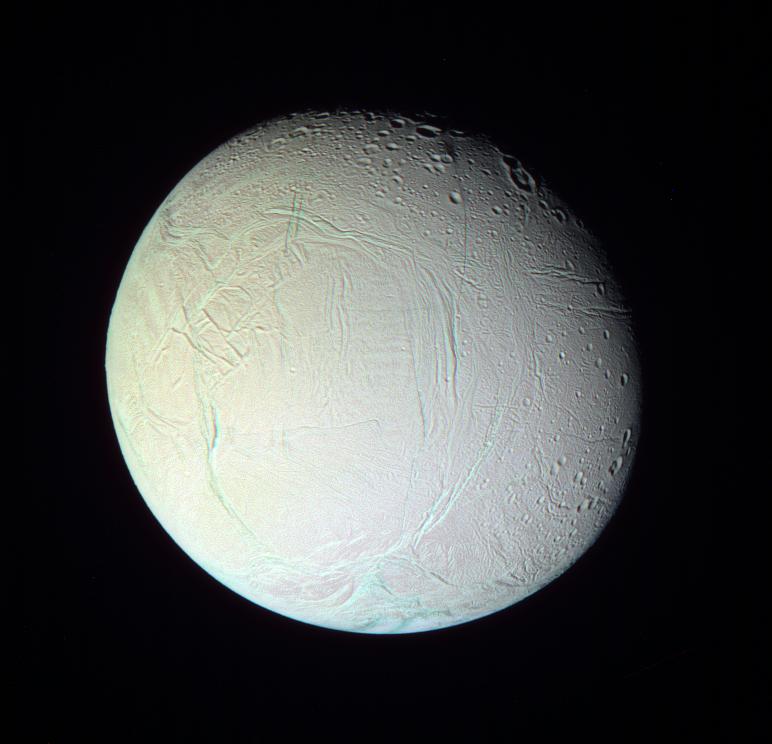
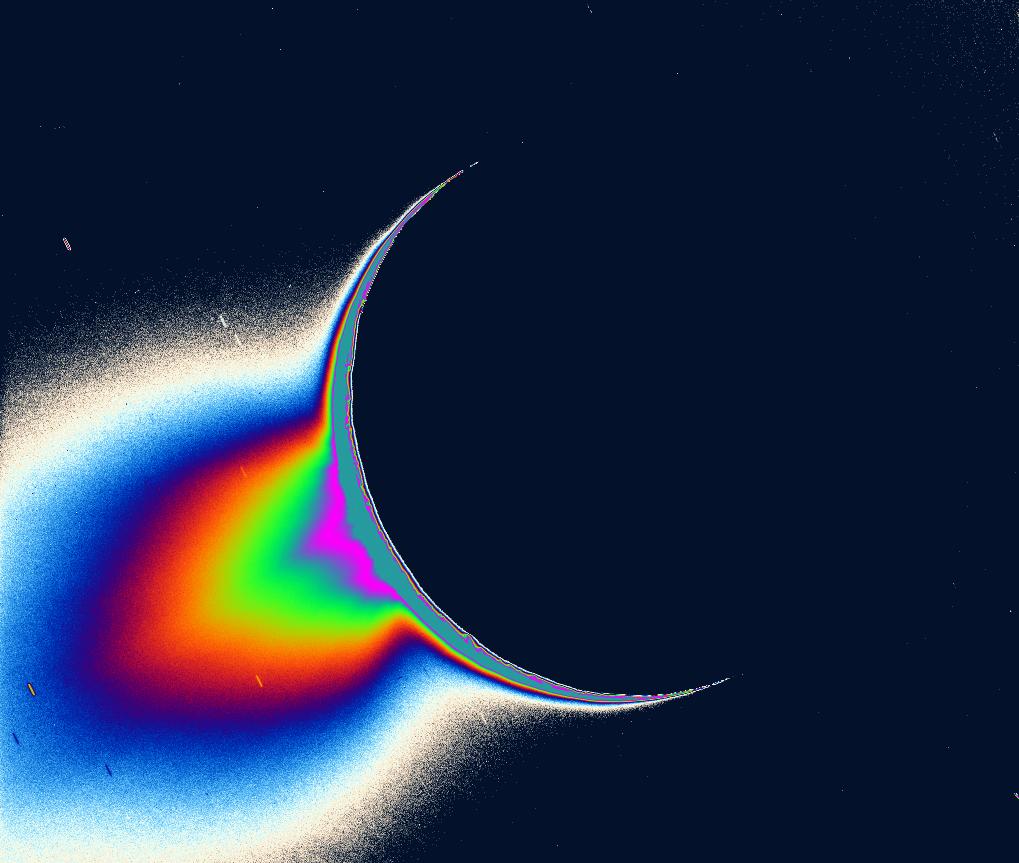
Obviously, if Saturn and its moons are unlikely abodes for life, it is even less likely that life exists further out in the solar system. Uranus and Neptune are quite similar to each other in size, and with Jupiter and Saturn compose the "gas giant planets", and Pluto is a ball of frozen ice. None of these three planets are likely places for life to exist.
All in all, there are really only three realistic sites for harboring life in our solar system: Mars, Europa, and Ganymede (and perhaps Saturn's moon Enceladus). Life on Mars will either be alive and in a form that has taken shelter beneath the soil, or it will be in a fossilized state. With warm water oceans beneath Europa, Ganymede, and Enceladus, these moons may be the most likely places to find actual living creatures in our solar system (besides the Earth).